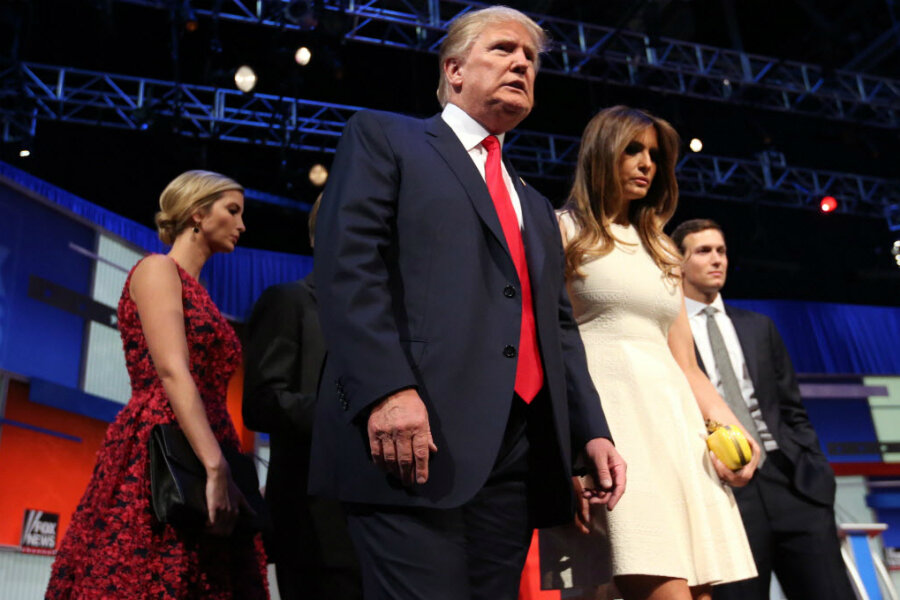Donald Trump: the son of an immigrant
For a presidential candidate whose rhetoric about immigrants isn’t exactly welcoming, Donald Trump has a rich personal immigrant history.
True, Mr. Trump has said “good people” should be allowed, even encouraged, to move to the US. After the 11 to 12 million undocumented immigrants in the US are deported under a Trump administration, the good people among them “are going to be expedited to come back," Trump told John Dickerson of CBS News on Sunday.
So it’s not as if Trump just wants to completely wall the nation off.
But as Mr. Dickerson pointed out, how do you determine who the “good people” are? It’s not easy.
In response to this question Sunday, Trump sidestepped a bit, and mentioned that “we want people to go our colleges," and that graduates of good US schools shouldn’t be thrown out as soon as they finish a degree.
Does that mean education is a “good person” key? Because under that criterion, a 16-year-old apprentice barber fleeing military service in his homeland, a non-English speaker, with no money, might not qualify.
That was Trump’s grandfather: Friedrich Trump (some sources spell the surname “Drumpf”).
The teenage Friedrich Trump arrived in New York City on Oct. 17, 1885. He was alone, although his older sister Katherine met him on the dock. They were from the village of Kallstadt in southwestern Germany.
Trump prospered in the New World. But it took time and was not easy. With money earned barbering, he eventually struck out West, buying and running diners and inns in Seattle and later British Columbia. Some of these were dives on the rough side of town.
Around 1900, Trump decided to cash out and return to his homeland, permanently. He took his stake back to Germany and married a former neighbor. But the authorities determined that he had become an American and had fled Germany to avoid the army and tax obligations. He and his pregnant bride were expelled.
“The Trumps were to be Americans after all,” wrote Gwenda Blair in her book, “The Trumps: Three Generations That Built an Empire."
The couple had a son, Frederick, in New York City, in 1905. This was Donald Trump’s father. His birth in America, and subsequent automatic US citizenship, disproves rumors that The Donald is himself an “anchor baby” born to noncitizen US immigrants.
Fred Trump’s story is well-documented. Beginning at age 15, he developed modest houses and apartments in New York City’s outer boroughs. He grew rich due to a ferocious work ethic and attention to detail.
Fred Trump’s New York Times obituary notes that he concealed his German origins from World War II until the 1980s, maintaining that he was Swedish. He had many Jewish tenants and felt they would be less likely to do business with a German.
In 1930, Fred Trump met a young Scot in New York on holiday, Mary MacLeod. They married in 1936. Born on the Isle of Lewis, Trump’s mother was proud of her Scottish heritage. Nevertheless, she became a US citizen on March 10, 1942.
“A patriotic move, it was also prudent for the wife of a man doing wartime construction for [the US military],” wrote Ms. Blair.
Donald Trump was born four years later.
Unlike some of his siblings, Trump over his lifetime has shown little public interest in his first-generation immigrant mother’s origins. As an adult, his first visit to her hometown was in 2008. He was on his way to testify in Aberdeen in regards to his proposal to build a large golf complex on the grounds of an old estate.
“I feel Scottish,” he said after visiting his mother’s ancestral cottage.
Trump’s final personal link to immigration is, of course, his wives.
His first spouse, Ivana Zelnickova, moved to New York from Czechoslovakia in 1976. She wed Trump in 1977. They are the parents of three children, including Ivanka, who introduced Trump at his presidential candidacy announcement.
Trump’s third and current wife, Melania Knauss, is a native of Slovenia. Their son was born in 2006.
Determining the legal status of these women at the time of their Trump weddings is “challenging," notes the debunking website Snopes.com. But given they were women of means on their own, and were dating one of the richest men in the country, it’s likely they had established legal status.
In any case, their children with Trump were born to a US citizen father. The charge that these kids would have been affected by Trump’s proposal to end birthright citizenship, if it had been in place at the time, is thus untrue, according to Snopes.
A paternal grandfather who seized on the opportunities offered by a youthful nation. A young woman who just happened to meet a young man. A hardworking father who – for a while – thought it best to pretend to be from elsewhere. Exotic foreign beauties.
That’s Donald Trump’s American heritage story. Like many such stories, it’s complicated, and it doesn’t involve the Mayflower.






